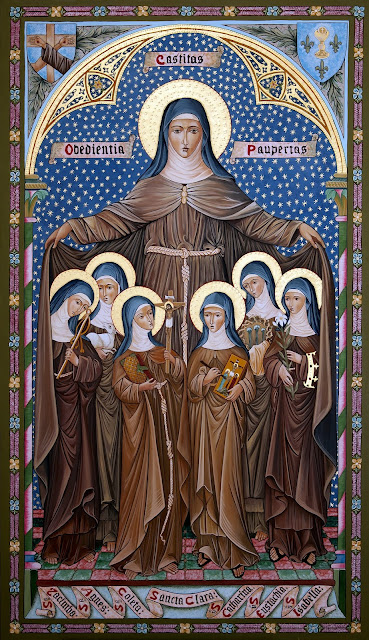St Clares first sisters
Following a period of reflection, during which Clare met Francis on several occasions to speak with him about God, Clare decided to choose a life of radical evangelical poverty. During the night of Palm Sunday, Clare secretly left her family’s home in Assisi and hurried down to the Porziuncola, where Francis cut her hair and gave her the habit of penance, right at the altar of the Saint Mary of the Angels. That same night Clare was escorted to the Benedictine monastery of San Paolo in Bastia Umbra, where she was protected by papal interdict against possible intrusion by her family to take her back home.
After some weeks Francis transferred Clare to another monastery at the foot of Mount Subasio, Sant’Angelo di Panzo. The first women to join Clare were her relatives—two sisters (one of them Catherine, later Saint Agnes of Assisi), cousins, and her widowed mother, Ortulana—and childhood friends; over time, women came from other regions, from families of the nobility and of the emerging merchant and artisan classes of the communes.
All attempts by their uncle Monaldo to take them back by force proved futile for the two girls were valiant.. Francis then brought Clare and Agnes to the small church of San Damiano and gave them a Form of Life, which is the basis of the Rule of Saint Clare. San Damiano was to be the place where Clare lived a cloistered contemplative life, but with great apostolic horizons, until the day of her death in 1253.
The first sisters to join her would be called the Poor Ladies of San Damiano, an order of nuns now called the “Poor Clares.” Saint Clare and her sisters wore no shoes, ate no meat, lived in a poor house, and kept silence most of the time. Yet they were very happy, because the Lord was ever close to them. In choosing to live at San Damiano, outside the walls of the city, without protection and with the common folk, Clare was throwing in her lot with the poor. The women who joined Clare came not only from the wealthy class but also from simpler origins. Clare desired one class of sisters, who would labor side by side as well as pray together in the Divine Office and the Mass.
On two different occasions God saved both Sisters and the town from a great danger in answer to Saint Clare’s prayer. One time an army of Saracen soldiers came to attack Assisi, planning to raid the convent first. Although very ill, Saint Clare had herself carried to the door and there, she had the Blessed Sacrament placed. Then on her knees, she begged God to save the Sisters. “O Lord, protect these Sisters whom I cannot protect now,” she prayed. A voice seemed to answer: “I will keep them always in My care.” At the same time a sudden fright struck the attackers and they fled as fast as they could.
Saint Clare was ill and suffered great pains for many years, but declared that no pain could trouble her. So great was her joy in serving the Lord that she once exclaimed: “Love God, serve God; everything else is within those two things.”
Saint Clare’s Form of Life does not involve any renunciation of the beauty of the world, no denial of joy and no contempt for material things. She withdrew herself from the world to give herself wholly to the Lord. Clare discovered in Jesus Christ her wealth. The riches and the pleasures that this world affords lose their power to attract in the light of the love of God. Clare found a far greater treasure – that hidden treasure in the field the Bible speaks of, that pearl of great price that the merchant in the Gospel parable gives all his wealth to possess (cf. Matt 4, 44-46). Clare renounced many things so that she could devote herself entirely to Christ Jesus.
Clare was the first woman to write her own Rule which received papal approval two days before her death. Her way of life spread rapidly even in her own lifetime, and in her wisdom her rule reflects a great flexibility and respect for the women who would follow her example in other times, places and cultures. Thus the Rule of Saint Clare has remained relevant throughout the centuries.
Clare died in 1253, twenty seven years after her mentor and guide, Saint Francis.
Get a pack of 5 digital images of Saint Clare, now on sale





Comments
Post a Comment